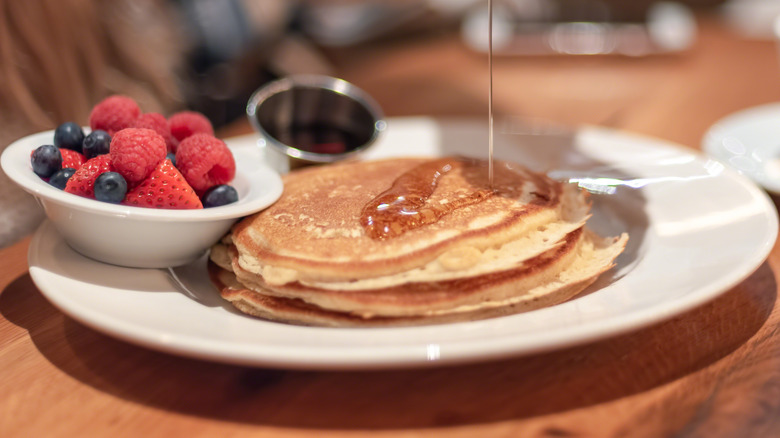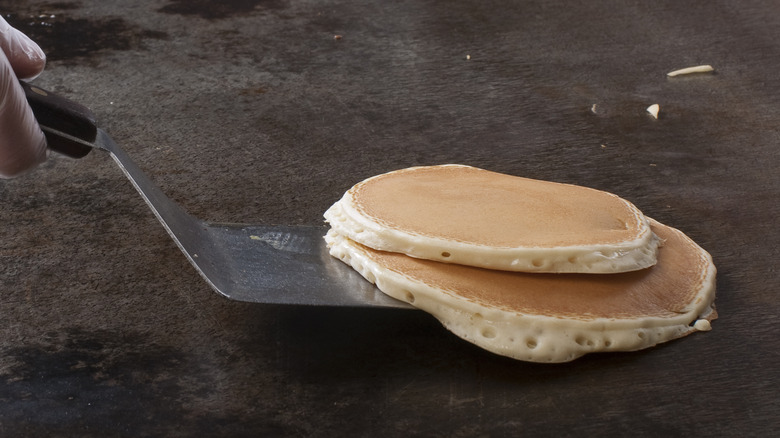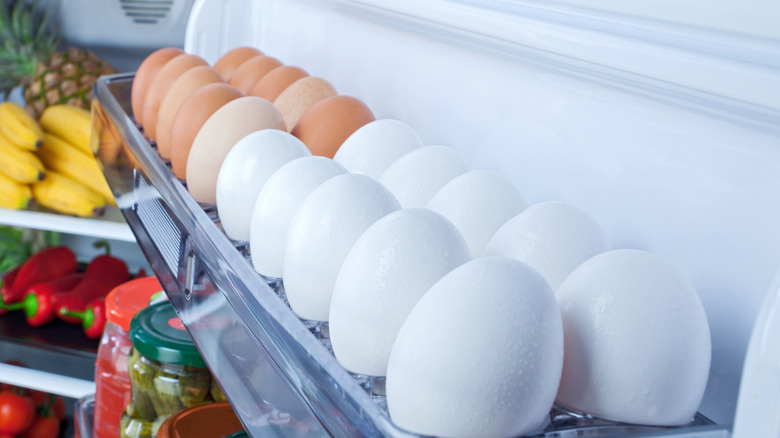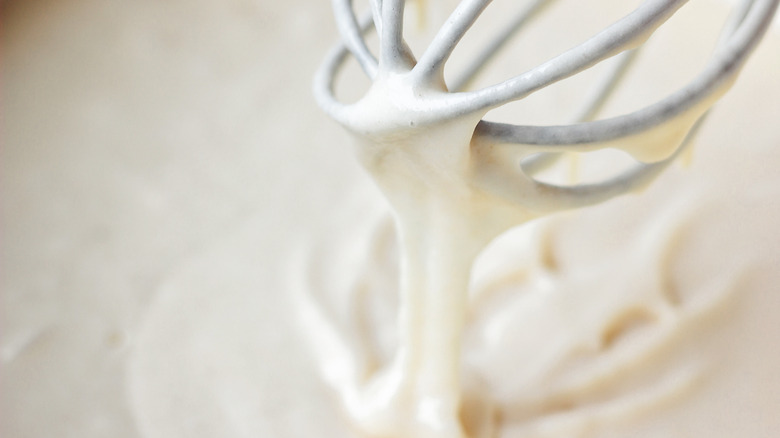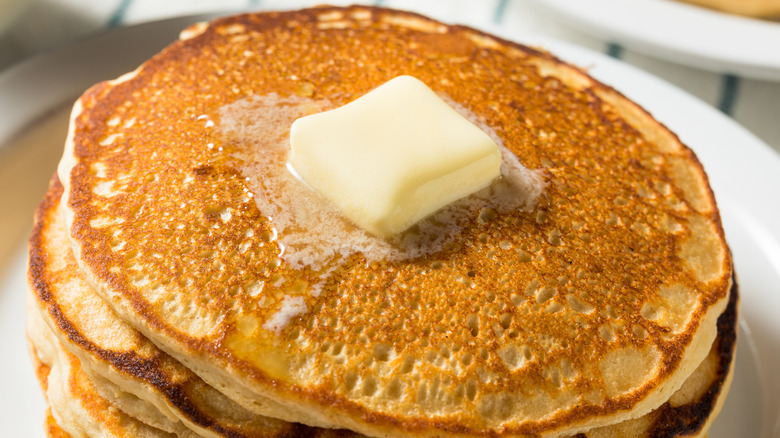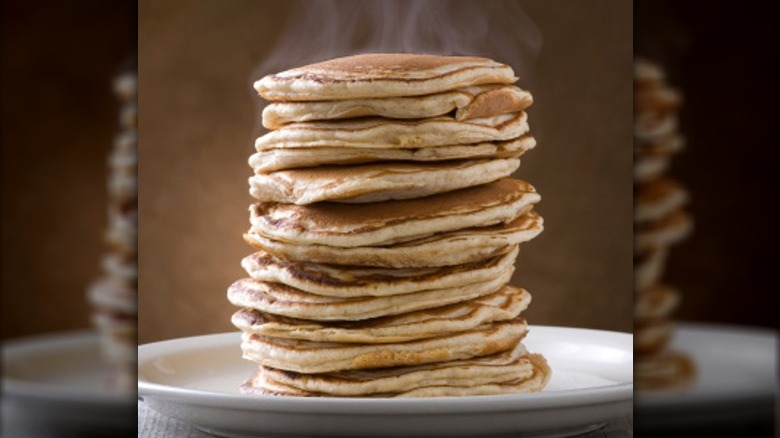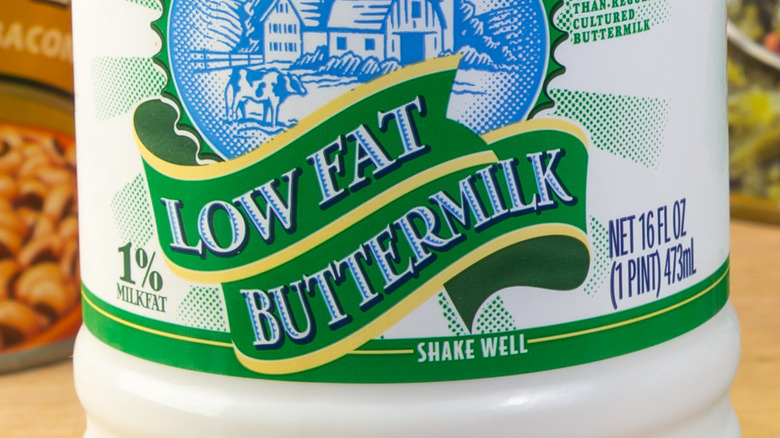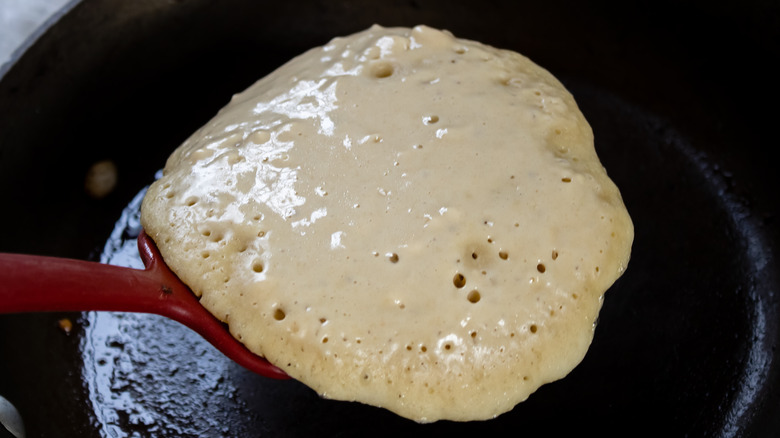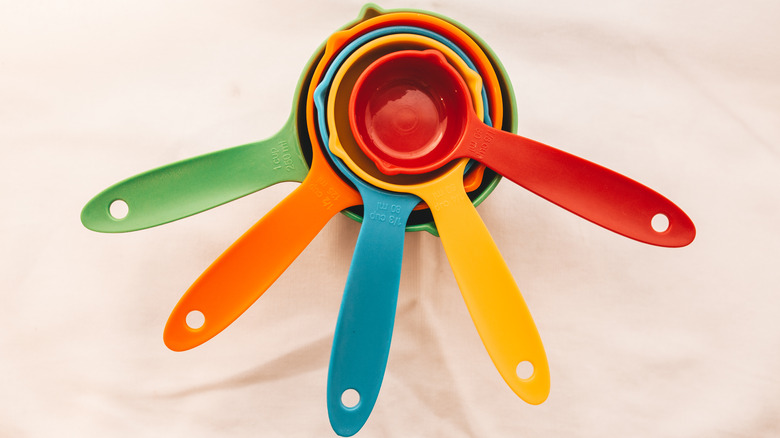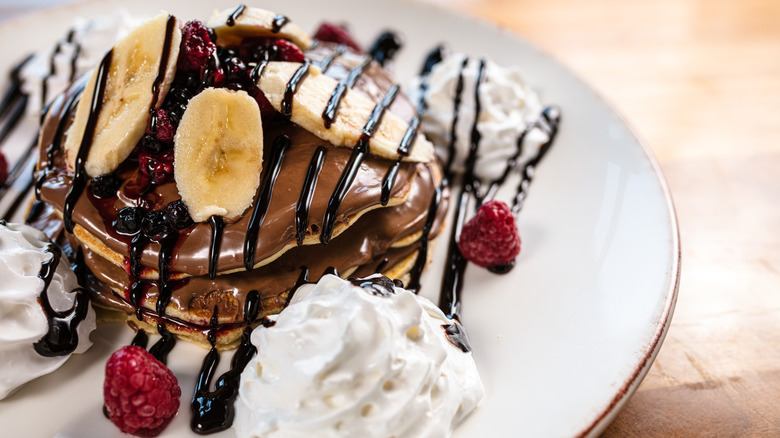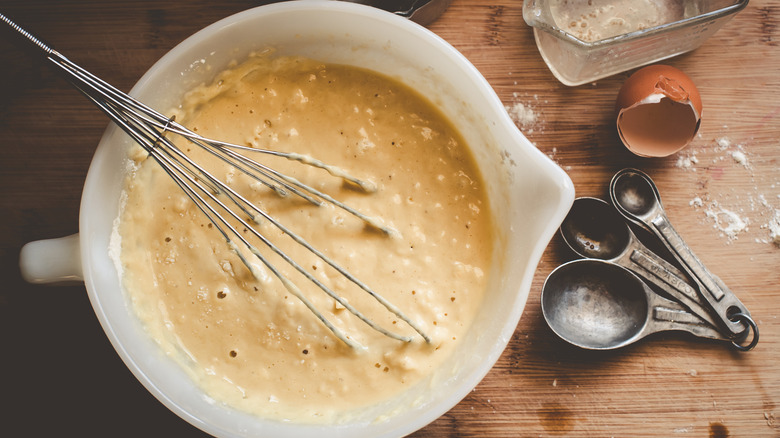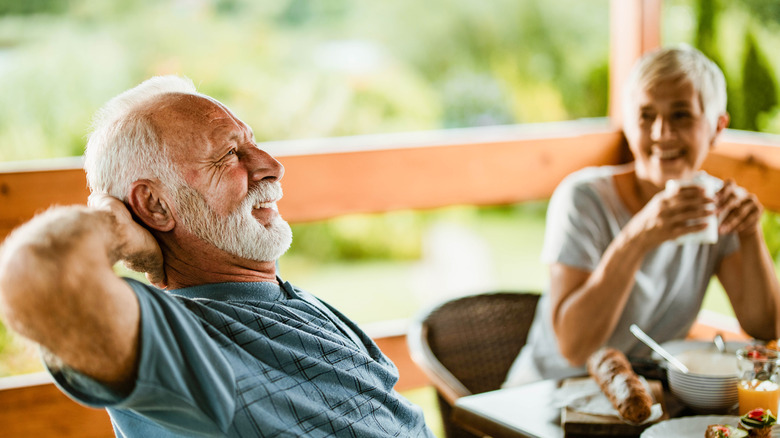Why Pancakes Always Taste Better At A Restaurant
Whether you call them flapjacks, griddle cakes, or roundy yums (the preferred U.K. terminology, as "New Girl" taught us), pancakes will always tickle the sweet tooth. Of course, no matter how many pancakes we've whipped up at home as early-morning meals (or late-evening desserts), we've yet to match the joyful scrumptiousness found in a hot, buttery, maple syrup-soaked pancake prepared at a restaurant.
Nothing tops the glorious sight of a thick, fluffy stack of pancakes being placed before you by a restaurant server. After all, while any competent home cook can fry up a plateful of pancakes, it's virtually impossible to reach the immensely high bar set by the pros who flip flapjacks in a restaurant setting (particularly when you're eating at a diner). But why is it that professionally prepared pancakes consistently outshine amateur offerings — and is it possible to replicate a restaurant-quality pancake in your own kitchen?
Well, provided you learn (and understand) the various reasons behind the general superiority of restaurant-made pancakes, you can absolutely incorporate at least some of the techniques used by professionals. So if you're wondering why a restaurant's pancakes so often take the, uh, cake compared to your own, we've got you covered. Without further ado, here's why pancakes always taste better at a restaurant.
Restaurants use hot griddles that are perfectly-calibrated for quick, even cooking
We can't ever recall cooking a bad pancake at home (or, at least, one that wasn't still edible). Yet we also have to admit our amateur cooking skills often seem to be lacking when compared to the pros. Thankfully, the issue may have less to do with our own culinary prowess than we thought, and everything to do with the fact we've usually cooked pancakes in a standard frying pan. After all, most restaurants make pancakes on a flat-top griddle (and a consistently hot griddle at that).
The advantages of using a flat-top griddle (instead of a frying pan) when cooking pancakes aren't necessarily self-evident, but they aren't difficult to decipher, either. For starters, griddles are far less constricted space-wise, allowing restaurants to cook your pancakes in a shorter period of time. Additionally, griddles ensure the cooking surface stays perfectly heated both before and after the batter hits it — resulting in an evenly-cooked, griddle-kissed final product. Years of cooking on a griddle may also imbue it with that unique, indescribable flavor that comes with diner food, like a cast-iron frying pan.
You may not be able (or even want) to obtain a similarly large, restaurant-style griddle for your own home. But even a standard stove or countertop griddle will elevate your homemade pancakes miles above what's possible in a frying pan.
The batter ingredients remain fridge cold before cooking
The notion that you should let raw meat rest at room temperature for a period before cooking is widely known. But just because bringing meat to room temperature (so to speak) is a prerequisite for that food's preparation doesn't mean it's universally applicable to any food item. If you're wondering why your pancakes don't measure up to those served at a restaurant, you may want to follow the professionals' lead and leave your ingredients in the fridge until you're ready to mix the batter.
It may seem counterintuitive to keep ingredients as cold as possible before mixing them. Yet it's all a matter of science. The inclusion of any warm or room temperature ingredients in this type of batter can prematurely heat the gluten therein — which, in turn, drastically lowers the likelihood of producing the light, fluffy texture you desire. The sudden surge of heat you get when pouring batter onto the griddle or pan contributes to the texture.
If you're eager to recreate a restaurant-quality pancake at home, but aren't able to keep your ingredients chilled to just above 32 degrees Fahrenheit (aka water's freezing point), try to ensure no ingredient is warmer than 50 degrees Fahrenheit. As long as the ingredients stay below that temperature, you'll be one step closer to making IHOP-quality pancakes at home.
Professional cooks don't overwork the batter
It's no great mystery why restaurants are usually capable of producing a superior pancake to the average home chef. In fact, you're likely already aware of certain elements explaining why pancakes from a restaurant are consistently better than your own. But simply knowing something — like pancake batter functions best when you leave lumps in it — doesn't mean you'll always follow through. So if your own pancakes falter in comparison to a restaurant, you might need to stop overworking your batter.
Perhaps you've been led to believe a smooth, almost fully liquid product is the only advisable end result when mixing ingredients before baking. But similar to keeping ingredients frigid before being used, it comes down to the chemistry. When you whisk away every single lump in pancake batter, you risk overworking the gluten proteins to the point the molecules become thin, tight, and stretched out — leaving no room for air bubbles to expand.
Retaining lumps in the batter doesn't just ensure pancakes cook to a thick and airy texture (rather than thin and tough), though. It also helps keep any air bubbles from deflating after the food is removed from heat, raising your personally prepared pancake to a restaurant-quality level.
Butter usually isn't used during the cooking process
It goes without saying that butter is essential to one's enjoyment of pancakes (look no further than the image above for a reminder). Quite frankly, whether you're devouring a homemade or restaurant-prepared batch, there's simply no way to eat the perfect pancake without butter. But while the dairy-derived product's presence can't be discounted, you may want to withhold the butter while cooking the food.
You might be asking, 'How can this possibly be?' After all, butter elevates anything it's cooked with or added to, right? Well, the problem lies with how butter reacts to a griddle's hot temperature — namely, that it can start to brown and smoke at such high heat. Butter has one of the lowest smoke points of any oil or fat, starting to smoke at just 350 degrees Fahrenheit. Consequently, when you use butter during the cooking process, you run the risk of tainting your pancake with a burnt, unpleasant flavor.
Additionally, setting butter aside until after a pancake finishes cooking can result in a more even and aesthetically-pleasing item on your plate. And since we eat with our eyes first, it's no wonder why a restaurant's gorgeous, golden-brown pancakes are always a huge hit.
Restaurants ensure pancakes are served fresh and hot
In the food service industry, it's fairly common for restaurants to precook certain popular menu items ahead of time to allow for faster service. But this practice doesn't work if it's used with a food known to rapidly diminish in overall quality (and potential enjoyability) if it's not eaten right away. Pancakes fall into this category, which may be why your lukewarm pancakes miss the mark at home. After all, restaurants ensure pancakes are always served piping hot straight from the griddle.
Now, we recognize there may be extenuating circumstances constraining a home cook when it comes to pancake preparation in this area. For example, if you're making pancakes for a family meal, and only have space to cook two or three pancakes at a time, you're all but guaranteed to fail to serve each person a freshly-cooked pancake before it becomes chewy (even if you manage to keep the pancakes warm in the interim).
Conversely, restaurant kitchens are often intricately organized (human-powered) machines, structured to ensure each individual pancake order is cooked and served both hot and fresh to a table. In other words, one reason pancakes may always taste better at a restaurant is because of the immense skills (and efforts) of food service professionals.
Buttermilk is often used instead of regular milk
When we're at the store purchasing instant pancake mix (as we're often wont to do), we tend to prioritize choosing a brand that advertises buttermilk in its just-add-water variety. Of course, there's an excellent reason for this preference — one that also partially explains why pancakes always taste better at a restaurant. Many restaurants use buttermilk instead of dairy or plant-based milk when making pancakes, which changes the interaction of the ingredients before and during cooking — leading to a fluffier, more texturally satisfying, and tastier result.
As is so often the case when discussing pancake quality, the rationale for using buttermilk instead of dairy-based milk merely comes down to science, and how each variety of milk interacts with baking soda. Since buttermilk is more acidic than dairy (or plant-based) milk, it reacts differently when mixed with baking soda. Buttermilk produces a chemical reaction alongside baking soda that results in a lighter, fluffier product, whereas dairy milk's low acidity won't trigger the same reaction, leading to a potentially flat, uninspiring pancake.
Obviously, if you only have plain old dairy milk at your disposal, you can still produce a delicious pancake — and may be able to mimic buttermilk in those instances by adding a touch of additional acid to the batter.
Professional cooks don't necessarily wait to see bubbles before flipping a pancake
One of the more difficult obstacles we've encountered when attempting to cook a perfect pancake is timing — more specifically, recognizing (and nailing) the precise moment it's ready to be flipped. An easy-to-remember rule of thumb regarding pancakes suggests it's best to wait until bubbles begin to appear on top. But if you've been following this practice, it may explain why restaurants have had the edge over your home-cooked version.
We're not saying to completely disregard the search for bubbling batter when cooking pancakes, as this remains a crucial step in the process. But if you've exclusively found yourself waiting for a bounty of bubbles to proliferate along the top of a frying pancake, you should consider focusing just on the edges instead (presuming your goal is to follow a restaurant's lead to a more pleasurable pancake, of course).
Once the edges of your pancake appear solid (along with the first sign of bubbles), that's the moment you should grab your spatula. Of course, we're still trying to perfect the pancake-flipping technique, but timing is key. In that sense, the key to a restaurant-level pancake may simply lie in flipping it sooner than you normally do.
The ingredients are always perfectly measured and mixed
As some say, cooking is an art form, while baking is a science — and there's a lot of truth in that axiom. Not to say bakers or pastry chefs are less artistically inclined, per se, than their savory-focused counterparts. But if you've ever used too much or too little of an ingredient when baking, only to wind up with an inedible eyesore, you know that properly measured ingredients are essential to any baked item — or baking-adjacent foods, as in the case of pancakes. In fact, one of the reasons restaurants likely nail pancakes is because they follow a recipe's measurements precisely.
To be clear, we don't mean to insult any meticulous-minded individuals out there. Many home chefs go the extra mile to correctly measure ingredients, even using kitchen scales or sifting dry ingredients to ensure they fill a cup all the way to the top. But when it comes to whipping up a quick batch of pancakes, it's tempting to guestimate the measurements rather than get a tablespoon measure dirty.
Still, even if you're the type who prefers just-add-water pancake mixes to a scratch batch, you'll need to properly measure (and mix) your ingredients if you'd like to avoid a flat pancake. And since professional chefs aren't likely to deviate from the required ingredient measurements, you shouldn't either.
Restaurants have a wider variety of available toppings on hand
Classic, unadulterated pancakes are nothing to scoff at. A perfectly made pancake can be buttery, fluffy, and filling. But for those who aren't enthused by the prospect of a simple pancake, a vast selection of additional ingredients and toppings can be a tempting prospect. That's one clear-cut reason why pancakes can always taste better at a restaurant: there's often a wide variety to choose from.
Now, some restaurateurs may advise diners to be gentle with their choice of mix-ins or toppings. Yet there's a literal bounty of mouthwatering ingredients at one's disposal that can easily raise the quality of a restaurant-ordered pancake. Whether it's a classic mix-in like chocolate chips or blueberries, or a unique topping like a fruit compote or chocolate sauce, a restaurant is apt to have just about any pancake mix-in you're craving at its disposal (presuming it's well-stocked, of course). This is largely because restaurants are usually able to purchase food products at cheaper wholesale prices than individual consumers.
Frankly, it's difficult to dismiss the convenience of simply ordering (and receiving) whatever pancake topping tickles your fancy at a given moment. And since restaurants generally offer those options, it offers a strong hint as to why restaurant pancakes are so often phenomenal.
Restaurants let pancake batter sit before cooking -- but not too long
If you've been paying attention throughout this article, you're aware that restaurants likely prepare pancake batter with ingredients taken straight from the fridge rather than letting them first come to room temperature. But that doesn't mean restaurants take their cold-as-a-refrigerator pancake batter and immediately pour it onto the griddle. In fact, one way restaurants produce consistently top-notch pancakes is by letting the batter rest for a period after mixing it — but not too long.
Obviously, restaurants aren't prone to mixing a bowl of pancake batter and then leaving it on the counter for hours on end. After all, the longer a mixed pancake batter rests (after the ingredients are combined), the longer it has to chemically react and change its baseline structure — leading to thinner, less springy-and-toothsome pancakes.
Restaurants likely leave the batter to rest for at least 10 minutes (but no more than 60 minutes) before using it. So for those hoping to emulate the professional's pancakes, be patient during the preparation process, and you'll reward your taste buds by doing so.
You don't have to do any work to enjoy a delicious short (or tall) stack
Some may believe a preference for restaurant pancakes insinuates laziness. But if there's something wrong with (occasionally) embracing a slothful approach toward breakfast, we don't think we want to be right.
If you're someone who abhors cooking, regardless of the type of food or cuisine in question, that's perfectly acceptable. After all, we're never going to shame a person who's willing to pay a premium for a restaurant-prepared meal in lieu of doing the work themselves. Of course, this hints at another reason why pancakes always taste better at a restaurant — namely, the fact that you don't have to do any actual cooking.
Perhaps you work in a kitchen setting professionally and simply don't want to perform any work-like tasks while you're off the clock. Or maybe you're a parent who's spent years throwing together meals for your children (and spouse) and would like to enjoy a Sunday brunch in the relaxing atmosphere of a restaurant. Whether you're looking to enjoy a laidback (and effortless) meal or the notion of cooking makes you want to squirm, not having to cook pancakes yourself can really add to the enjoyment.
If you derive satisfaction from making your own (potentially-subpar) pancakes at home, all the power to you. As for us, we'll continue enjoying pancakes from a restaurant sans any effort.
